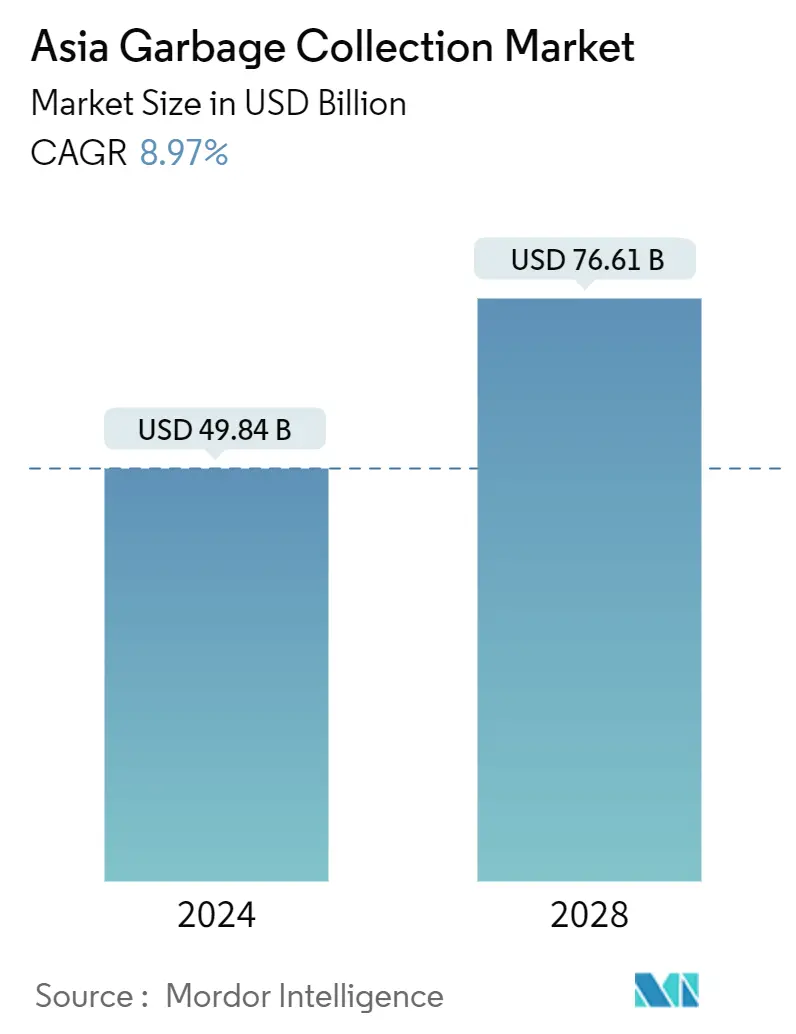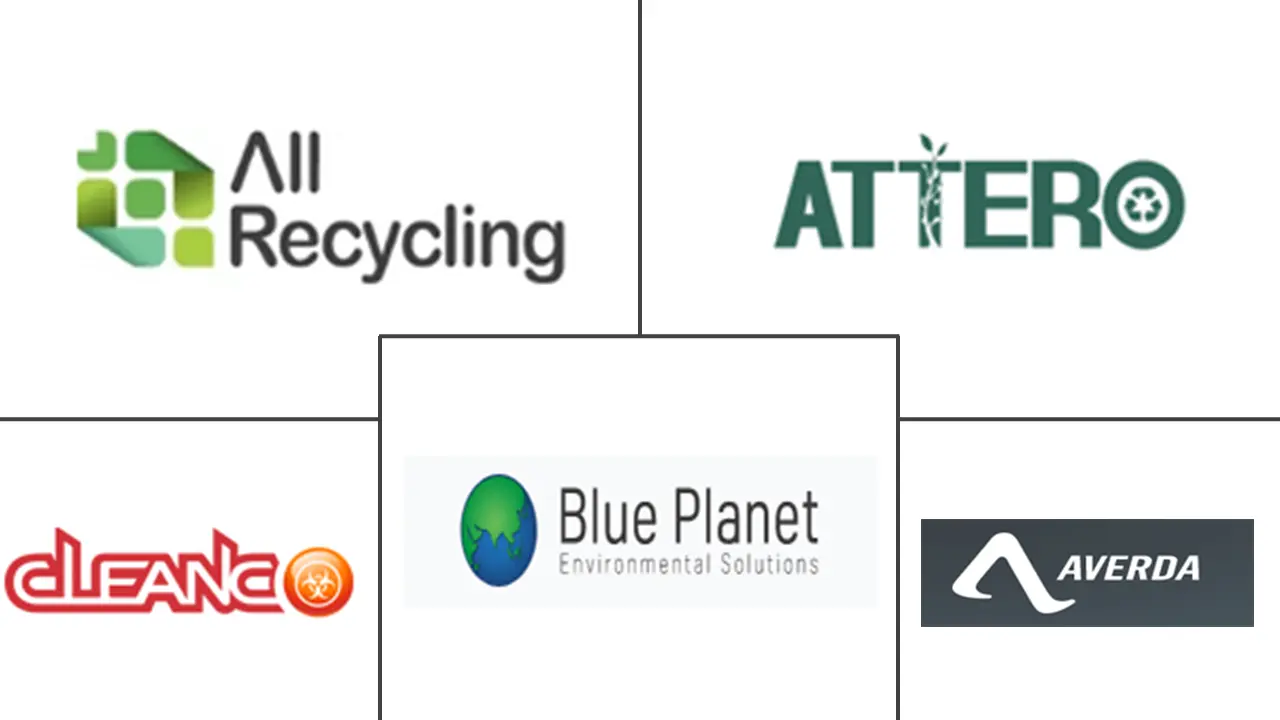Market Size of Asia Garbage Collection Industry

| Study Period | 2020-2029 |
| Market Size (2024) | USD 49.84 Billion |
| Market Size (2029) | USD 76.61 Billion |
| CAGR (2024 - 2028) | 8.97 % |
| Fastest Growing Market | Asia |
| Largest Market | North America |
Major Players
*Disclaimer: Major Players sorted in no particular order |
Asia Garbage Collection Market Analysis
The Asia Garbage Collection Market size is estimated at USD 49.84 billion in 2024, and is expected to reach USD 76.61 billion by 2029, growing at a CAGR of 8.97% during the forecast period (2024-2029).
- In Asia, governments and organizations are focusing on developing efficient waste management systems to tackle the challenges of waste disposal and environmental impact. Many countries in Asia are implementing modern waste collection methods, such as waste-to-energy plants and recycling initiatives.
- One of the biggest factors is the rapid population growth and urbanization happening in many Asian countries. As more people move to cities, the amount of waste generated increases significantly. This presents a challenge for governments and local authorities to effectively collect and manage the waste.
- In response to this challenge, many countries in Asia are implementing modern and innovative waste management systems. These systems focus on sustainable practices such as recycling, waste-to-energy conversion, and composting. They aim to reduce the amount of waste going to landfills and minimize the environmental impact.
- Another important factor is the increasing awareness and emphasis on environmental sustainability. People are becoming more conscious about the impact of their waste and are demanding better waste management solutions. This has led to the emergence of recycling programs, waste segregation initiatives, and public awareness campaigns across the region.
- Each country in Asia has its unique approach to garbage collection. For example, in Japan, they have a highly organized waste management system with strict recycling rules. In Singapore, they have implemented a pay-as-you-throw system to encourage waste reduction.
- Overall, the Asia garbage collection market is evolving and adapting to meet the increasing waste management needs of the region. It's an important industry that is continuously working towards sustainable waste management practices.
Asia Garbage Collection Industry Segmentation
The garbage collection market refers to the industry involved in collecting, transporting, and disposing of waste materials. It encompasses various activities such as curbside pickup, recycling programs, and waste management technologies. Factors like population growth, urbanization, and environmental regulations drive the market. It plays a crucial role in maintaining cleanliness and sustainability in our communities.
The Asia garbage collection market is segmented by product type, waste type, collection type, end-user, and region. By product type, the market is segmented by waste disposal equipment, waste recycling, and sorting equipment. By waste type, the market is segmented into hazardous waste and non-hazardous waste. By collection type, the market is segmented by curbside pickup, door-to-door collection, and community recycling programs. By end-user, the market is segmented by municipal waste management, healthcare, chemical, mining, etc. By region, the market is segmented by China, Japan, India, and Rest of Asia.
The report offers the market sizes and forecasts for the Asia garbage collection market in value (USD) for all the above segments.
| By Product Type | |
| Waste Disposal Equipment | |
| Waste Recycling | |
| Sorting Equipment |
| By Waste Type | |
| Hazardous Waste | |
| Non-Hazardous Waste |
| By Collection Type | |
| Curbside Pickup | |
| Door-to-door Collection | |
| Community Recycling Programs |
| By End User | |
| Municipal Waste Management | |
| Healthcare | |
| Chemical | |
| Mining |
| By Region | |
| China | |
| Japan | |
| India | |
| Rest of Asia |
Asia Garbage Collection Market Size Summary
The Asia garbage collection market is experiencing significant growth, driven by rapid urbanization and increasing population density in the region. Governments and organizations are prioritizing the development of efficient waste management systems to address the challenges posed by waste disposal and environmental impact. This has led to the adoption of modern waste collection methods, including waste-to-energy plants and recycling initiatives. The emphasis on environmental sustainability is also rising, with public awareness campaigns and recycling programs gaining traction. Each country in Asia is adopting unique approaches to waste management, such as Japan's organized recycling system and Singapore's pay-as-you-throw model, contributing to the evolving landscape of the garbage collection market.
In addition to general waste management, the handling of hazardous waste is becoming increasingly critical in Asia due to rapid industrialization and economic growth. Industries such as manufacturing, chemicals, and healthcare are significant contributors to hazardous waste generation, necessitating specialized knowledge and infrastructure for safe disposal. The diversity of hazardous waste materials, including toxic chemicals and infectious waste, presents further challenges. Regulatory frameworks and enforcement are crucial in ensuring safe handling and disposal practices. In India, the waste management sector is expanding rapidly, supported by government initiatives like the Swachh Bharat campaign and the Integrated Waste Management System. These efforts are aimed at addressing the growing waste production due to urbanization and population growth, highlighting the urgent need for effective waste management solutions in the region.
Asia Garbage Collection Market Size - Table of Contents
-
1. MARKET DYNAMICS AND INSIGHTS
-
1.1 Market Overview
-
1.2 Market Dynamics
-
1.2.1 Market Drivers
-
1.2.1.1 Increasing awareness among consumers
-
1.2.1.2 Environment concerns and sustainability
-
-
1.2.2 Market Restraints
-
1.2.2.1 The cost of production and transportation
-
1.2.2.2 Regulations and quality standards
-
-
1.2.3 Market Opportunities
-
1.2.3.1 The demand for sustainable solutions
-
1.2.3.2 Regional and local market expansion driving the market
-
-
-
1.3 Industry Attractiveness - Porter's Five Forces Analysis
-
1.3.1 Bargaining Power of Suppliers
-
1.3.2 Bargaining Power of Buyers
-
1.3.3 Threat of New Entrants
-
1.3.4 Threat of Substitutes
-
1.3.5 Intensity of Competitive Rivalry
-
-
-
2. MARKET SEGMENTATION
-
2.1 By Product Type
-
2.1.1 Waste Disposal Equipment
-
2.1.2 Waste Recycling
-
2.1.3 Sorting Equipment
-
-
2.2 By Waste Type
-
2.2.1 Hazardous Waste
-
2.2.2 Non-Hazardous Waste
-
-
2.3 By Collection Type
-
2.3.1 Curbside Pickup
-
2.3.2 Door-to-door Collection
-
2.3.3 Community Recycling Programs
-
-
2.4 By End User
-
2.4.1 Municipal Waste Management
-
2.4.2 Healthcare
-
2.4.3 Chemical
-
2.4.4 Mining
-
-
2.5 By Region
-
2.5.1 China
-
2.5.2 Japan
-
2.5.3 India
-
2.5.4 Rest of Asia
-
-
Asia Garbage Collection Market Size FAQs
How big is the Asia Garbage Collection Market?
The Asia Garbage Collection Market size is expected to reach USD 49.84 billion in 2024 and grow at a CAGR of 8.97% to reach USD 76.61 billion by 2029.
What is the current Asia Garbage Collection Market size?
In 2024, the Asia Garbage Collection Market size is expected to reach USD 49.84 billion.

